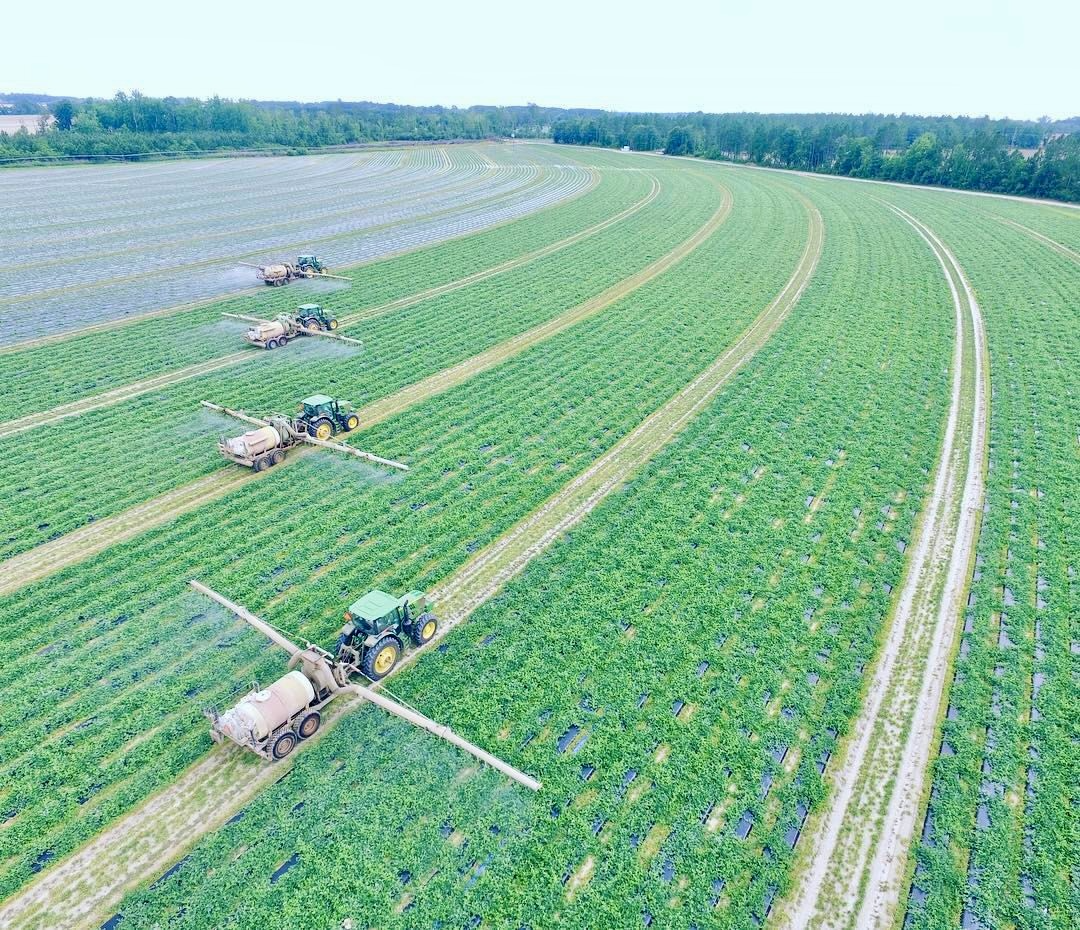Stay ahead of the curve as a political insider with deep policy analysis, daily briefings and policy-shaping tools.
Request a DemoAg preservation study committee hears problems over loss of farmland to development

Tractors in the field taking care of baby melons in Tifton. (Credit: Lewis Taylor Farms)
- Georgia has lost 20% of its farmland over the past 50 years
- Land development projects have taken over 2.5 million acres
- Much of the lost farmland is now the site of homes, apartment complexes
The Gist
Georgia has lost 20% of its farmland since 1974, much of it covered by sprawling subdivisions, gated communities and apartment complexes.
Between 1974 and 2016, developed land in the state grew by 2.5 million acres, more than the size of Delaware and Rhode Island combined.
“The loss of viable ag land is a concern,” Georgia Agriculture Commissioner Tyler Harper told the Study Committee on the Preservation of Georgia’s Farmlands Tuesday during its first meeting. The committee, which was created earlier this year to find ways to preserve Georgia’s dwindling farmland, met in Statesboro.
The committee also heard from experts on land, water and natural resources as well as an agribusiness teacher at Ogeechee Technical College and a south Georgia farmer who has embraced land-conserving techniques.
“The economic and environmental future here in Georgia is going to depend on the integrity of our land, the way that we use and the way that we steward our land,” Katherine Moore, president of the Georgia Conservancy, told the committee. The conservancy conducted a 50-year analysis of Georgia’s changing landscape called Georgia Now & Forever. “Proactive, intentional decisions about our land use, our land reuse and our land stewardship are the way that we need to think about our future.”
What’s Happening
Georgia communities have developed land quickly and broadly over the past 50 years, adding roads, homes, condominiums, apartment complexes, golf courses, warehouses, shopping centers, office buildings and other developments.
Between 1974 and 2016, developed land in the state grew by 2.9 million acres, more than the size of Delaware and Rhode Island combined, Moore noted.
Metro Atlanta, Augusta, Columbus, Macon and Savannah saw the biggest increase in developed land during that time.
Millions were born in or moved to Georgia for jobs, bringing the Peach State’s current population to 11 million. And millions more are expected. Georgia’s population is expected to reach over 13 million by 2050.
“We’re going to have to figure out a way to curb the low-intensity development,” Moore said. “I want to be very clear: This is not me saying we should not have housing choice. This is an opportunity for communities to think about different ways to provide development in their community, making sure they have a diversity of options.”
Complicating matters is the fact that 85% of Georgia’s surface water — a key ingredient for farming and agribusiness — is contaminated because of rain runoff or aging water pipes, wells and other infrastructure, Asli Aslan, director of Georgia Southern University’s Institute for Water and Health, said.
“Every time somebody flushes a toilet, it ends up somewhere in a water resource, in soil and water. How do we actually address that?” Aslan said.
Aslan also noted that residents in 120 of Georgia’s 159 counties have private wells, many of which are aging and haven’t been tested in years.
About 10% of Georgia’s land is permanently conserved. That’s less than North Carolina, where 16% is conserved, and 30% in Florida, which has about double Georgia’s population. North Carolina’s population is just under Georgia’s.
“If we ever find ourselves in a resource crisis [where] we don’t have enough land for housing, we are lacking the type of land we want for ag or for timber, it’s probably because we’ve made some poor land use or land stewardship decisions,” Moore said. “Going forward, it is impossible to be successful in thinking about conservation of our natural resources if we don’t contemplate a partner method for addressing the very real housing needs that our state has; these must go together.”
State lawmakers have made efforts to address Georgia’s dwindling farmland by:
- Approving the preservation study committee this year to look into the issue.
- Passing Senate Bill 420, which bans foreign adversaries from buying Georgia farmland.
- Passing the Georgia Farmland Conservation Act, which last year established the Conservation Fund in the state Department of Agriculture. The $2 million received this year for the fund “will go a long way with helping us start preserving our farmland,” Harper said, adding it will also help Georgia “attract federal dollars.”
Why It Matters
“Our land is a limited resource,” Moore said. ”So how are we going to accommodate millions more by 2050?”
South Georgia farmer Grant Anderson takes the state’s dwindling farmland to heart. He told the committee he had “a strong sense of responsibility to figure out how to bring better-quality food options” to Georgia.
Anderson uses hydroponic shipping containers to grow lettuce. Hydroponics is a technique that uses a nutrient-rich water solution instead of soil to grow plants. His 8-year-old company, Better Fresh Farms, located in Metter, produces seven acres’ worth of lettuce a year on less than an acre, using “95% less water than pivot irrigated lettuces.” His business has grown from three to 10 employees and from two 40-foot shipping container farms to eight.
“Lettuce is the most widely consumed leafy green in the United States, accounting for roughly one-fifth of the $21.8 billion vegetable and melon industry in 2022, and considering nearly every single restaurant has a use for it, I felt it was a natural start,” Anderson said. He also noted most of the nation’s lettuce supply comes from California and Arizona.
“That’s a long trip,” he said.
In addition to growing lettuce, Anderson has a $27 million plan for local agriculture waste processing and alternative food production in Candler County.
“With all the agricultural knowledge and experience present here in this room today,” Anderson said, “I’m confident we can figure out how best to leverage this emerging industry to better feed our growing population, plan to more efficiently utilize the acreage we still have available to farm and advance ever closer towards food sovereignty for Georgians.”
Harper closed the meeting by urging the committee to consider further participation in conservation programs; promote the agriculture industry through Georgia Grown, his department’s marketing and economic development program; and provide more grants, ag policies and safety net programs.
What’s Next?
The committee will hold three more meetings throughout the state before wrapping up with a final meeting in November at the Capitol in Atlanta. The committee will then present its findings and recommendations to the Legislature.
The next committee meeting is scheduled for Aug. 30 in Cornelia. The remaining meetings are set for Sept. 25 in Moultrie, Oct. 28 in Cedartown and a yet-to-be-determined November date in Atlanta.

GEORGIA AGRICULTURE AT A GLANCE
Agriculture’s ranking among industries in Georgia: No. 1
Agriculture jobs: 323,300, or 1 in 7 Georgians
Georgia’s economy tied to agriculture: 17%
Contribution to Georgia’s economy: $83.6 billion a year
Farms: 40,000
Average farm size: 235 acres
Source: Georgia Department of Agriculture
Related stories
Have questions, comments or tips? Contact Tammy Joyner on X @lvjoyner or at [email protected].
COMMENTARY: Happy 100th birthday, Mr. Jimmy!
“I missed you at Sunday school today,” Mr. Jimmy said to me as he entered the back door of what once was a boarding house where his parents lived when they were first married. He always stopped to speak with me in the kitchen before mingling with the nearly 45 people gathered in anticipation of …
Want to see the election process up close? Become a poll worker
Looking for a temporary job that gives you a glimpse of how the American election process works? If so, Georgia election officials are looking for you. Many local election offices have begun training thousands of temporary poll workers and other essential staff for the Nov. 5 general election, according to W. Travis Doss III, president …
Rogers, Slotkin lean into China, national security in US Senate battle
LANSING, Mich. — Michigan voters are faced with a choice for U.S. Senate in November between two candidates with strong national security credentials but with sharply different views on how to effectively address threats to the U.S. Both Southeast Michigan candidates, Republican Mike Rogers of White Lake and Democratic U.S. Rep. Elissa Slotkin of Holly, have been …
Tammy Baldwin faces tough reelection: Can Trump supporters push her past the finish line?
MADISON, Wis. — Tammy Baldwin may need some Donald Trump supporters to secure her reelection. The two-term U.S. senator plays up the “buy American” language she pushed for federal infrastructure projects and touts policies favored by Wisconsin’s dairy industry such as seeking to ban labeling plant-based products “milk.” Her GOP rival Eric Hovde, meanwhile, wants …




